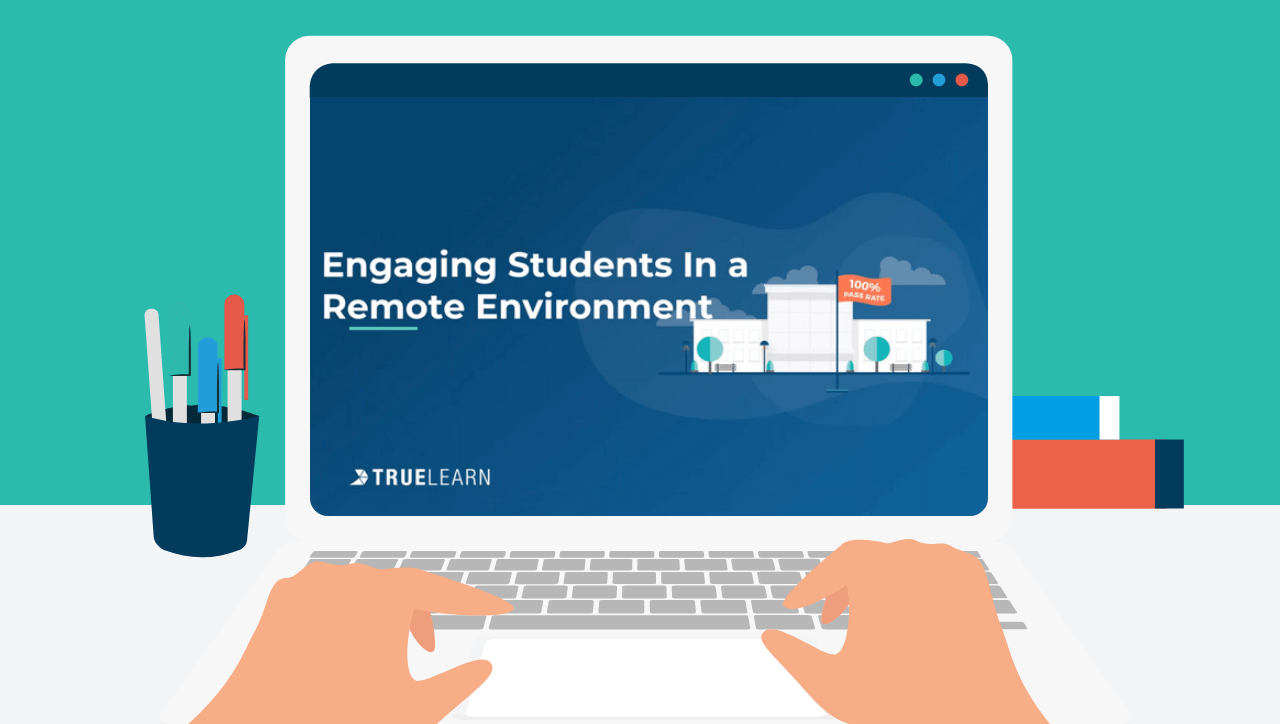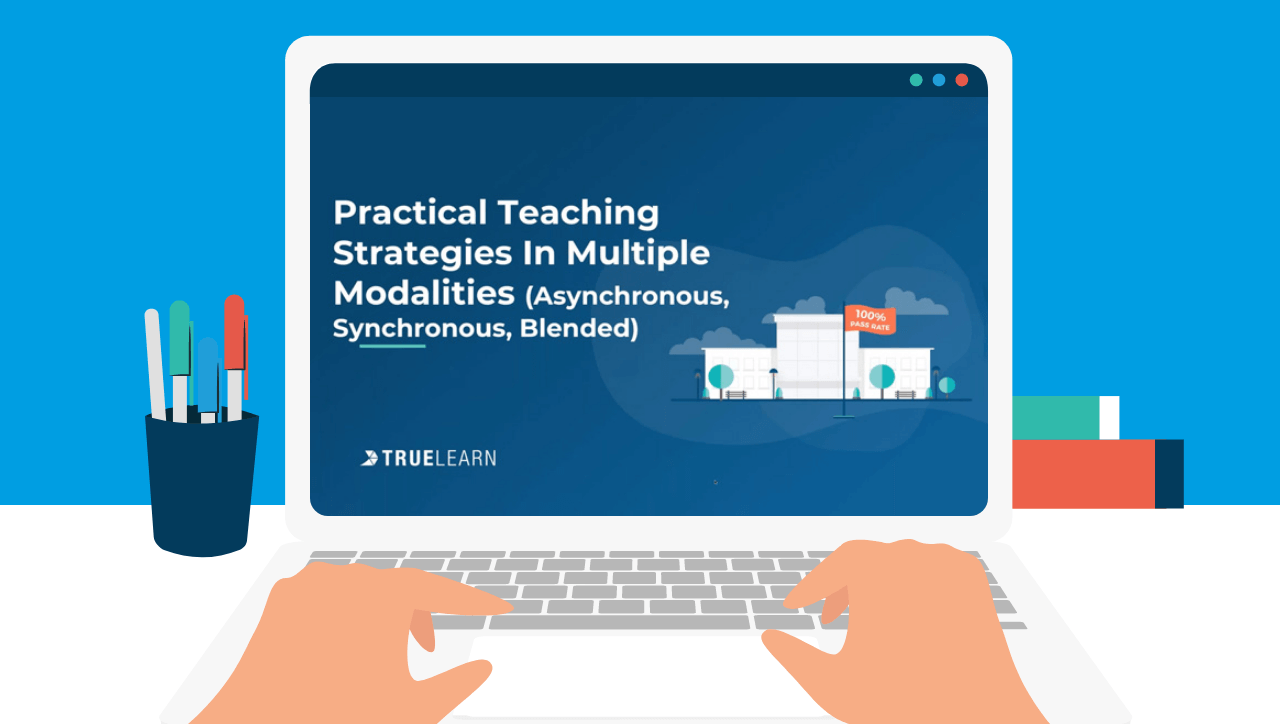The Impact of Sleep on Adult Learning and Memory

Like maintaining a healthy diet and engaging in regular exercise, sleep is a cornerstone of overall well-being, directly influencing brain performance and learning outcomes. Sleep often feels like a luxury for adult learners balancing academic, work, and personal responsibilities. Yet, it plays a critical role in cognitive health. So, what is healthy sleep? Three essential factors define it: getting enough rest to allow the brain to recover, ensuring sleep is uninterrupted and restorative, and maintaining a consistent schedule to align with the body’s natural rhythms.1 These components create the foundation for effective memory consolidation, cognitive performance, and learning success.
In this blog, we will explore the positive and negative impact of sleep on learning and memory, practical ways to help learners prioritize sleep, and five proven learning science strategies to leverage for enhancing sleep prioritization.
How Sleep Quality Affects Learning and Memory in Students
When it comes to academic success, sleep is a fundamental factor that impacts learning and memory. It is not merely a period of rest but a crucial time when the brain actively processes, organizes, and stores information.2 For adult learners, understanding how sleep quality affects these processes is key to optimizing their academic performance.
Sufficient sleep supports essential brain functions by enabling the brain to process and store information, which is vital for long-term retention. Conversely, insufficient sleep disrupts these functions, creating significant barriers to effective learning. Here are the positive impacts of sufficient sleep and the negative effects of sleep deprivation on adult learning:
| Positive Impacts of Sufficient Sleep | Negative Impacts of Sleep Deprivation |
|---|---|
| Memory Consolidation During sleep, particularly during deep non-REM and REM stages, the brain consolidates new information, transferring it from short-term to long-term memory.3 | Impaired Memory Sleep deprivation disrupts the brain’s ability to consolidate memories, making it difficult to retain new information or recall previously learned material.4 |
| Improved Cognitive Function Quality sleep enhances attention, problem-solving skills, and decision-making abilities, all of which are vital for academic performance.5 | Reduced Cognitive Function Lack of sleep impairs attention, alertness, and problem-solving, diminishing learning efficiency.6 |
|---|
| Enhanced Creativity and Problem-Solving Sleep, especially REM sleep, fosters creativity by allowing the brain to form novel connections and integrate disparate ideas, leading to innovative solutions.7 | Decreased Motivation and Focus Fatigue resulting from inadequate sleep diminishes motivation and the ability to concentrate, leading to decreased engagement in learning activities.8 |
|---|
| Mood Regulation Adequate sleep helps regulate emotions, reduce stress, and enhance motivation, which contributes to a positive learning environment.9 | Increased Stress and Anxiety Sleep deficiency exacerbates stress and anxiety, disrupting focus and memory retention. |
|---|
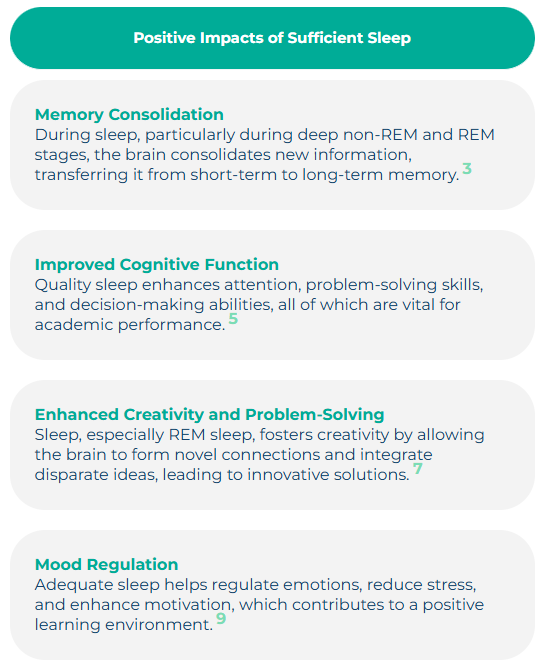
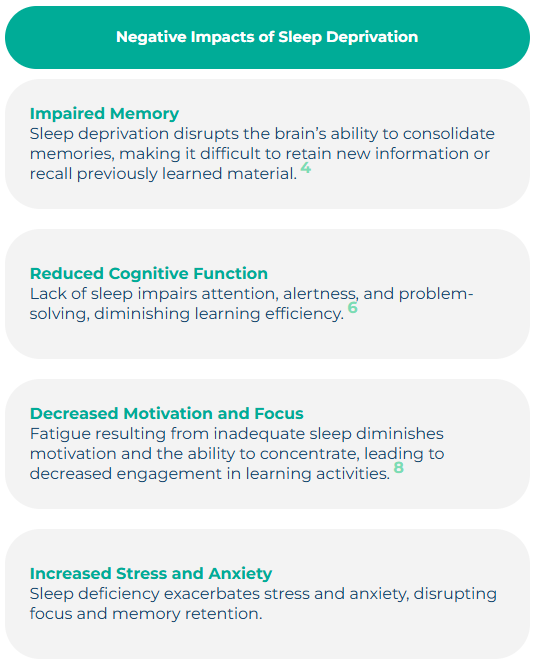
Ways to Help Adult Learners Prioritize Sleep
While adult learners face challenges in prioritizing sleep, educators can make a difference by incorporating practical sleep strategies into their teaching practices to improve their learners’ overall well-being and aim to improve cognitive performance. Here are two ways that educators can help adult learners prioritize sleep:
1. Emphasize the Link Between Sleep and Learning
Explicitly Teach Sleep Science
Educate learners on the science of sleep and its critical role in processes such as memory consolidation, focus, and problem-solving. Understanding the connection between sleep and cognitive performance helps learners recognize the value of sleep in achieving academic success.
How to: Educators can explain how the brain processes and stores information during sleep, emphasizing its role in transferring knowledge to long-term memory and how sleep deprivation disrupts these functions.
Use Real-World Examples
Sharing research findings and relatable success stories can help learners understand the critical role sleep plays in learning and memory. Real-world examples provide tangible proof of how prioritizing sleep positively impacts performance, fostering motivation and engagement.
How to: Educators can introduce studies showing the relationship between adequate sleep and improved academic outcomes, such as higher test scores and better memory retention. They can also share stories of successful individuals who experienced significant gains by making sleep a priority, making the concept relatable and inspiring.
Facilitate Class Discussions
Facilitating discussions about sleep allows adult learners to self-reflect on their habits, share challenges, and explore solutions collaboratively.
How to: Educators can create structured opportunities for learners to discuss their sleep patterns, challenges, and strategies that have worked for them. By asking open-ended questions or organizing small-group activities, educators can encourage learners to share experiences and motivate each other to prioritize healthy sleep habits.
2. Promote Healthy Sleep Habits
Healthy sleep habits are critical for enhancing learning and memory. By fostering consistent routines and reducing stress, educators can help learners improve their cognitive performance, memory retention, and overall academic success.
Encourage Consistent Sleep Schedules
A regular sleep-wake cycle plays a significant role in maintaining focus, energy, and cognitive efficiency. Consistency strengthens the circadian rhythm, enabling the brain to consolidate memories more effectively.
How to: Educators can encourage learners to establish fixed bedtimes and wake-up times, even on weekends, to support a regular sleep pattern. Explaining how irregular schedules interfere with the brain’s ability to process information and retain knowledge can underscore the importance of consistency in sleep routines.
Create a Relaxing Learning Environment
Stress can negatively affect the impact of sleep on learning and memory by disrupting the brain’s ability to process and retain information. A calm, focused learning environment helps learners manage academic pressure while improving their sleep quality.
How to: Encourage mindfulness exercises, such as deep breathing or reflection, during class activities to help learners reduce stress and improve focus. Simultaneously, educators can incorporate active learning strategies, to boost engagement and better understanding of the content.
Provide Practical Sleep Resources
Simple changes in daily routines can significantly improve sleep quality and, in turn, learning outcomes. Practical tools and strategies empower learners to develop healthier habits that support their academic goals.
How to: Offer actionable tips such as avoiding screens before bed, engaging in calming activities like stretching or reading, and creating a sleep-friendly environment that is dark, quiet, and cool.
Leveraging Learning Science to Help Learners Prioritize Sleep
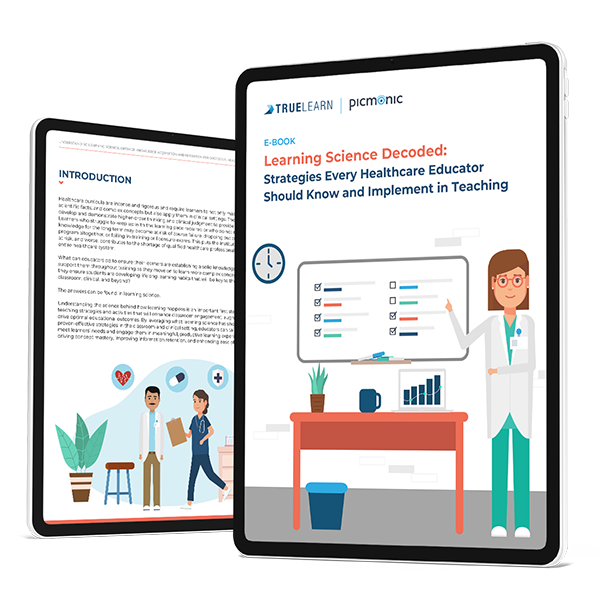

Get our latest eBook Now!
Get our latest eBook Now!
Learn how to leverage learning science theories and proven strategies to optimize knowledge acquisition and retention among healthcare learners by downloading our free eBook.
While promoting healthy sleep habits is essential, deploying proven learning science strategies ensures effective and efficient learning, freeing up time to maintain sufficient sleep. These methods optimize study efforts, helping learners balance mastery of a rigorous curriculum with restorative rest. Here are five evidence-based strategies to optimize learning outcomes.
1 – Spaced Repetition
What is it: Spaced repetition is a learning technique that involves reviewing material at gradually increasing intervals. Initially, learners review content frequently, but as they become more familiar with the material, the time between reviews is extended. This “spacing effect” strengthens memory retention and reduces forgetting by encouraging the brain to repeatedly retrieve information, effectively combating the forgetting curve and supporting long-term memory retention.
How to guide:
- Encourage learners to review material immediately after learning and repeat it daily in the early stages
- As learners become more confident, extend the time between reviews to reinforce retention while avoiding cognitive overload
- Use tools like flashcards or review calendars to schedule and manage intervals effectively
How to apply it:
- Incorporate quick reviews of previous lessons at the start of each class
- Use quiz-based activities or digital tools that adjust to individual progress, ensuring learners focus on areas needing reinforcement
2 – Interleaving
What is it: Interleaving is a learning technique where learners alternate between related topics or concepts instead of focusing on one subject at a time (blocking). This method helps learners recognize patterns, compare concepts, and build a deeper understanding of the material. Unlike blocking, which often results in rote memorization, interleaving encourages active engagement with the content, improving memory retention and the ability to apply knowledge effectively.
How to guide:
- Suggest learners mix related subjects during their study sessions instead of focusing exclusively on one topic. For example, alternate between biology, chemistry, and physics during shorter intervals rather than dedicating an entire session to one subject
- Encourage learners to spread their study sessions over time and avoid trying to master one topic in a single night before an exam
- Include activities that require learners to identify differences and similarities between topics, enhancing critical thinking and reducing confusion
How to apply it:
- Create assignments or quizzes that blend questions from multiple subjects, requiring learners to switch between topics as they solve problems
- Introduce a topic, switch to a related one, and then return to the original topic later in the curriculum to deepen understanding
- Encourage interleaving in independent study: Guide learners to alternate between subjects or topics during their personal study time
3 – Practice Retrieval
What is it: Practice retrieval is a learning strategy where learners actively recall previously acquired information rather than passively reviewing it. This process strengthens memory retention, deepens understanding, and promotes higher-order thinking. Research shows that retrieval practice outperforms methods like re-reading notes or study guides, making it an essential tool for long-term learning.
How to guide:
- Encourage learners to actively recall information rather than passively reviewing notes. This engages the brain more deeply and prepares it for memory consolidation during sleep
- Use methods like low-stakes quizzes, group discussions, or brain dumps to help learners practice recalling material
- Retrieval activities can reveal areas where learners need further clarification, allowing educators to target these gaps effectively
How to apply it:
- Assign brain dumps where learners write down everything they remember about a topic, helping to solidify knowledge and identify gaps for further review
- Suggest that learners summarize material or answer self-generated questions from memory instead of re-reading notes, reinforcing understanding while aiding memory consolidation during sleep
4 – Elaboration
What is it: Elaboration involves connecting new information to what you already know, creating meaningful associations that strengthen memory retention. By integrating prior knowledge and personal relevance into the learning process, learners can form deeper connections, leading to better comprehension and recall.
How to guide:
- Motivate learners to elaborate on concepts by relating them to existing knowledge, asking “why” and “how” questions, or discussing their relevance to real-world situations
- Help learners form strong mental links by creating vivid imagery or tying information to personal experiences
- During review sessions, ask learners to explain material in their own words or expand on its significance, fostering critical thinking and memory formation
How to apply it:
- Encourage students to elaborate on concepts by answering questions that connect the material to broader contexts. For example, rather than memorizing the signs and symptoms of hyperglycemia, ask, “How does hyperglycemia relate to the body’s inability to regulate blood sugar? What are the potential long-term consequences if left unmanaged?”
- Design activities where learners relate concepts to their future profession or everyday scenarios, enhancing understanding and retention
- Facilitate group discussions where learners share their elaborations on key concepts, broadening perspectives and reinforcing knowledge
5 – Dual Coding
What is it: Dual coding explains that when verbal and nonverbal information is presented simultaneously, it activates two separate brain channels—one for processing words and the other for processing visuals. This dual activation strengthens memory by creating multiple pathways for recalling the same information.
How to guide:
- Use diagrams, charts, or videos alongside text-based explanations to illustrate key ideas
- Motivate learners to create their own visual aids, such as mind maps, flowcharts, or annotated diagrams, to reinforce their understanding
- Provide resources that combine written and visual information to engage learners more effectively
How to apply it:
- Encourage students to use visual aids or create mind maps during class or study sessions
- In lessons, provide visual representations, such as charts or infographics, alongside verbal explanations to reinforce learning
- Assign tasks where learners create visual summaries of key topics, helping them link ideas through multiple channels
By leveraging learning science strategies, educators can empower adult learners to enhance retention, deepen understanding, and apply knowledge effectively. When paired with healthy sleep habits, these methods optimize memory consolidation and cognitive performance, helping learners achieve their academic goals while maintaining their overall well-being.
Gain a deeper understanding of learning science theories and proven strategies you can implement to drive desired academic and program outcomes. Download our free eBook, Learning Science Decoded: Strategies Every Healthcare Educator Should Know and Implement in Teaching, and transform the way you support learner success.
References & Footnotes
1 Good sleep for good health. NIH News in Health. Accessed January 14, 2025. https://newsinhealth.nih.gov/2021/04/good-sleep-good-health.
2 Sleep and memory. Harvard.edu. Accessed January 14, 2025. https://sleep.hms.harvard.edu/education-training/public-education/sleep-and-health-education-program/sleep-health-education-88.
3 Importance to memory of replay and sleep. Mit.edu. Accessed January 14, 2025. https://picower.mit.edu/discoveries/importance-memory-replay-and-sleep.
4 kmh. From Zzzs to memories: How sleep habits shape cognitive function. The Daily. March 19, 2024. Accessed January 14, 2025. https://thedaily.case.edu/from-zzzs-to-memories-how-sleep-habits-shape-cognitive-function/.
5 Marketing, Communication. Why at least 7 hours of sleep is essential for brain health. U of U Health Publishing Team. June 26, 2023. Accessed January 14, 2025. https://medicine.utah.edu/neurology/news/2023/06/why-at-least-seven-hours-of-sleep-is-essential.
7 Rest is Essential for Learning & Productivity. Center for the Advancement of Teaching. October 2, 2020. Accessed January 14, 2025. https://teaching.fsu.edu/tips/2020/10/02/rest-is-essential-for-learning-productivity/.
8 The impact of sleep on learning and memory. Essayhub.com. Accessed August 25, 2025. https://essayhub.com/study/the-impact-of-sleep-on-learning-and-memory.
9 Vandekerckhove M, 1 Faculty of Psychology and Educational Sciences, Vrije Universiteit Brussel, 1050 Etterbeek, Belgium, Wang YL, 2 Department of Data Analysis, Faculty of Psychological and Pedagogical Sciences, University of Gent, B-9000 Gent, Belgium. Emotion, Emotion Regulation And Sleep: An Intimate Relationship. AIMS Neurosci. 2018;1(1):1-22. doi:10.3934/neuroscience.2018.1.1.
![How Educators Can Recognize and Help Students with Trauma [Webinar]](https://truelearn.com/wp-content/uploads/2020/11/Educator-Webinar-How-Educators-Can-Recognize-and-Help-Students-with-Trauma.png)
